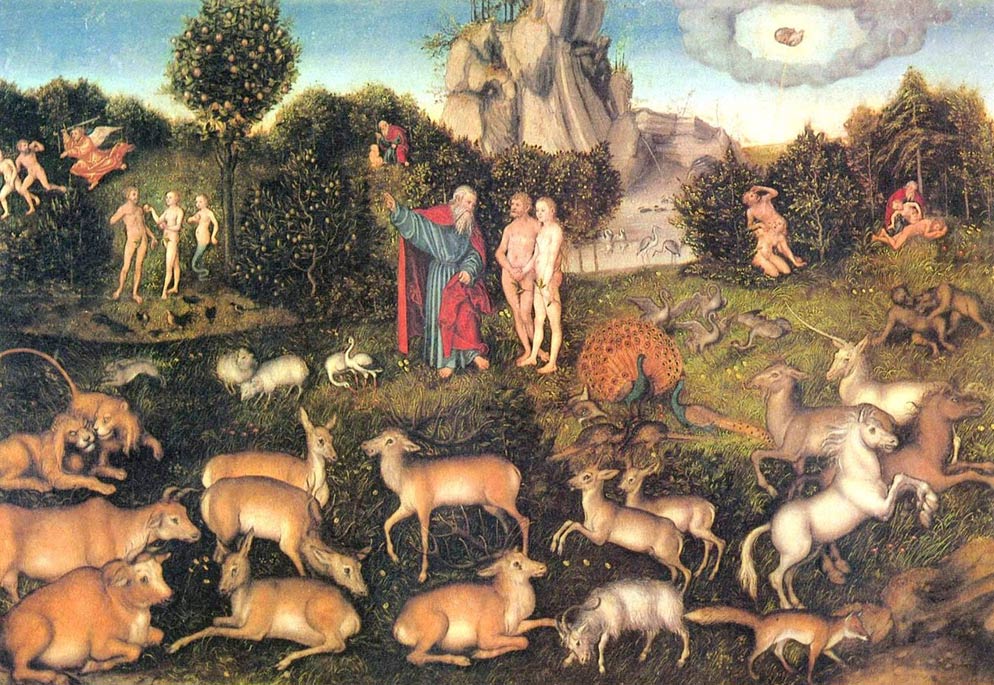
Was the Garden of Eden a Real Place?
Mention the Garden of Eden to a group of friends and you are likely to get as many suggestions on its true location as people you ask, plus a fair number who will deny that it was ever a real place at all. Places that have been claimed as the true whereabouts of mankind’s original home include numerous sites in Iraq and around the Persian Gulf, Bahrain, Iran, Anatolia, Armenia, Turkey, Jerusalem, east Africa – and even the Isle of Lewis, Scotland, and Jackson County, Missouri. And those are just the better known claims; there are literally hundreds.
Will we ever know for sure where it was, or even if it really existed? Given that most of the clues to the garden’s location come from ancient texts, will we ever find any new evidence to its whereabouts? As it turns out, remote sensing, archaeological and DNA studies have provided some compelling hints to its true location in recent years, and future work might well prove it once and for all.
The Original Legend
The Garden of Eden features in the creation stories of the Jewish, Christian and Muslim religions, being the place where Adam, the first man, and Eve, the first woman, were placed by God to live after their creation. The Book of Genesis, written around 500 BC, contains our main clues about its geographical location through a description of the rivers flowing through it and its proximity to a gold-mining area. Genesis 2:3 says: ‘Now a river flowed out of Eden to water the garden; from there it was separated into four headwaters. The name of the first is Pishon; it flows from the land of Havilah, where there is gold.[...] The name of the second river is Gihon; it flows around the whole land of Cush. The name of the third river is Tigris; it flows east of Assyria and the fourth river is the Euphrates.’
The Tigris and Euphrates are well known, they flow from Turkey through Iraq and into the Persian Gulf. But the Pishon and Gihon do not exist today – however science has given us a strong clue where the Pishon once was. In 1994 Dr Farouk El-Baz, Director of the Center for Remote Sensing at Boston University and a pioneering figure in remote sensing, used ground-penetrating radar images from the Space Shuttle to locate and trace the bed of an ancient river that flowed for about 600 miles (965 kilometers) through Saudi Arabia, ending in Kuwait where it became a broad watercourse three miles (almost five kilometers) wide.
This ‘Kuwait River’ as El Baz named it, also known as Wadi Al-Batin, is believed to have been flowing until around 2500-3000 BC and has its origins in Medina province in western Saudi Arabia in an area called Mahd adh Dhahab, also known as the Cradle of Gold, which has been the main gold-mining area in the Arabian Peninsula since at least 3000 BC. This lost river therefore appears to match well the biblical description of the river Pishon ‘flowing from the land of Havilah’, suggesting a probable northern Gulf location for the Garden of Eden, perhaps offshore modern Kuwait. The Gihon River however has not been unambiguously identified, but a strong contender is the Karun River which flows out of Iran to join the Pishon, Euphrates and Tigris just north of the Gulf.
When did all this happen? Two events help tie it down. The Pishon dried out around 4,500 years ago, so it must have been before then. Perhaps more importantly we know the northern Persian Gulf was largely a dry valley until around 10,000 to 8,000 years ago, so if the Garden existed beneath the present northern Gulf as we will see later it most probably did, then it must have been prior to this date.
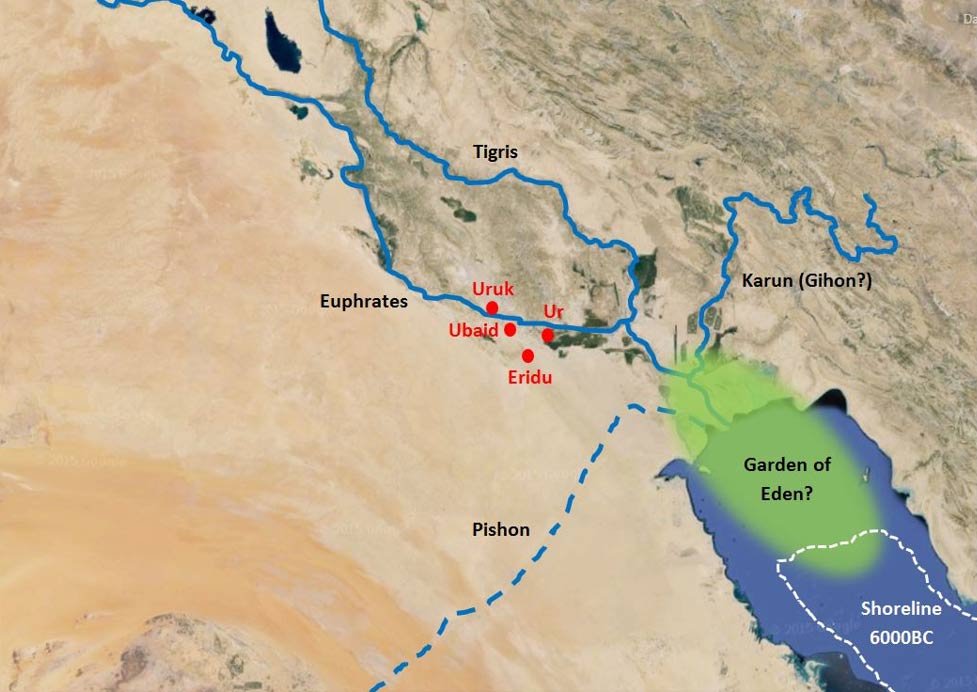
Geographical location of rivers mentioned in Genesis as flowing into the Garden of Eden, and the Garden's inferred location. Also shown are the earliest cities and the shoreline of the Persian Gulf as they existed at the time, around 8,000 years ago. Satellite image: Google Earth
The Cultural Background
So what do we know of the people who lived in the region of southern Iraq and northern Gulf at this time?
To start with the climate was very different then. From the time when the first humans came ‘out of Africa’ around 100,000 years ago the sea level had been around 400 feet (122 meters) lower than it is today, due to the vast amounts of water locked up in the northern ice sheets of the last ice age. As a result the Persian Gulf had been a fertile valley for millennia, during which time the climate had been through a number of wet and dry periods. But for most of that time the region was much less arid than it is today, and wildlife was much more plentiful with abundant herds of gazelle, wild cattle, camels and other animals.
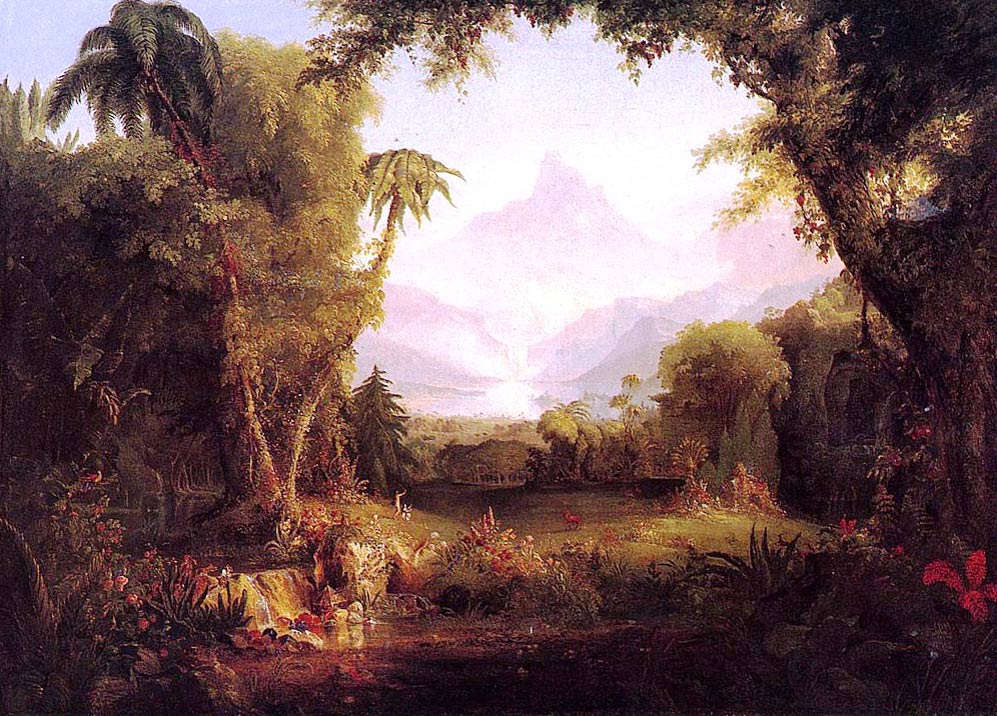
"The Garden of Eden" by Thomas Cole (c.1828) (Public Domain)
People were relatively plentiful too, having migrated from Africa into the Persian Gulf valley from both ends – crossing the Red Sea into Yemen and southern Oman and northwards, as well as crossing the Sinai Peninsula into the Levant and southwards. Originally they were hunter-gatherers, nomadic people who followed the herds who were in turn following the moisture and the vegetation.
Then sometime around 30,000 BC the people of this region started to develop agriculture. They learned to irrigate, grow crops and save seed for the following year, to enclose herds of cattle and goats instead of following them. For the first time in human history people settled in one place. As a result of being settled with a reliable food source they claimed their own territories, and built permanent houses. Around 8,500 to 6,500 years ago they built the world’s first cities in what is now Jordan and Iraq – cities such as Jericho, Uruk, Ur and Eridu.
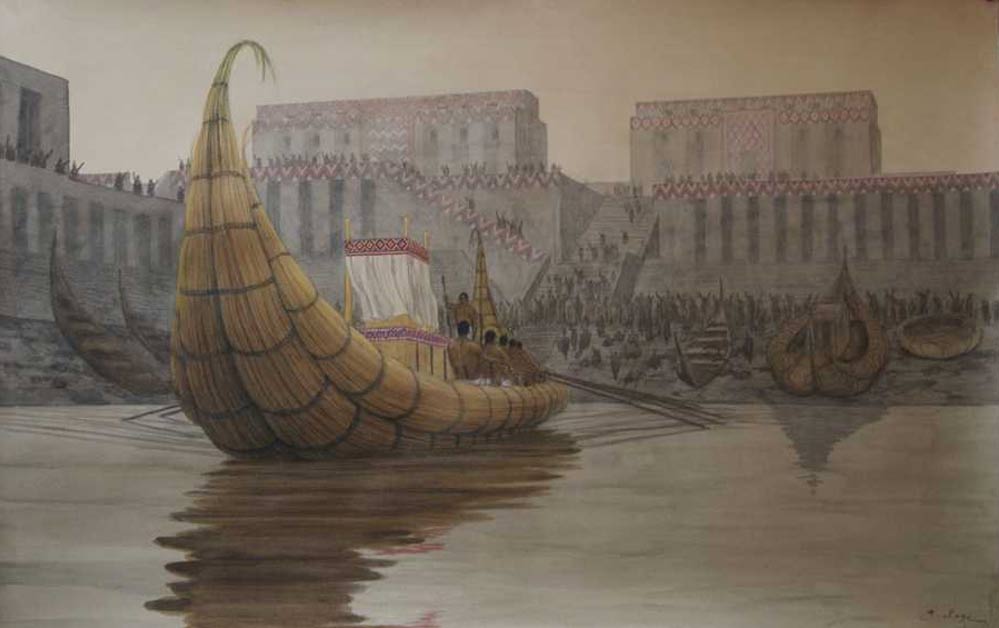
Illustration depicting a recreation of the ancient port at Eridu. (Public Domain)
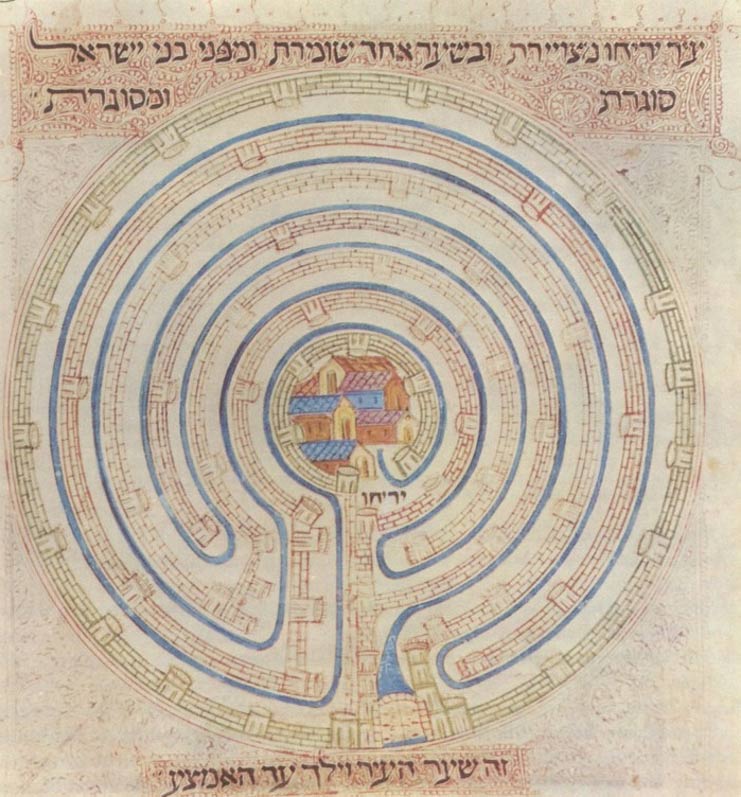
Map of Jericho in Farchi Bible, 14th century. (Public Domain)
The people who created them were the Ubaidians, Sumerians, Assyrians and Kashshites, and it was therefore these tribes – rapidly becoming civilizations through the development of metallurgy – who around 8500 BC were living in the region which Genesis tells us the Garden of Eden was to be found.
With cities came culture and eventually the invention of writing, and hence the world’s first literature – the earliest clay tablets with cuneiform writing that have been found date from around 2600 BC, which brings us to the events that those earliest books recorded, the most dramatic of which was ‘the flood’.
The Flood Myth
The story of the flood is first mentioned in a number of the world's earliest documents, notably the Sumerian Eridu Genesis dating from about 2300 BC and the Epic of Gilgamesh from 1900 BC. The details of the myths are remarkably consistent between the two, and are clearly the basis for the later and more familiar story of the flood in the Bible and the Quran. Since both texts were written close to the Persian Gulf it is a reasonable hypothesis that they reflect actual events which took place in the region prior to 2300 BC.
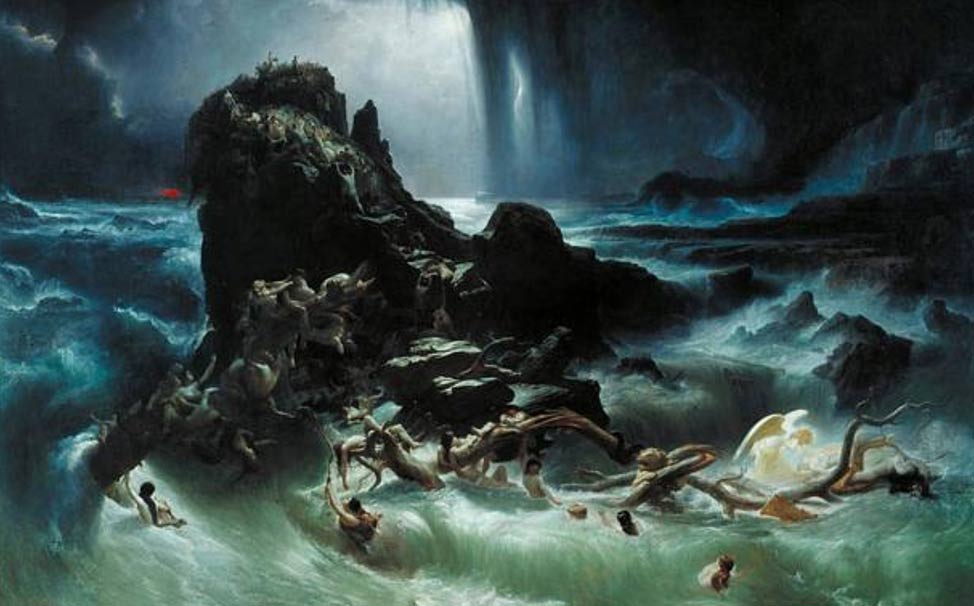
‘The Deluge’ by Francis Danby, 1840. (Public Domain)
In the Eridu Genesis the god Enki warns a man named Ziusudra that the gods have decided to destroy mankind in a flood, and instructs him to build a large boat in order that he and his family may survive and repopulate the earth. After a flood lasting seven days Ziusudra makes sacrifices to the gods and is given eternal life in Dilmun (the old name for Bahrain).
Compare that with the Babylonian Epic of Gilgamesh, in which a man named Utnapishtim is warned of the impending deluge by the god Ea, who gives him instructions on how to build a boat in order that he can save himself, his family and cattle, after which the gods made him immortal.
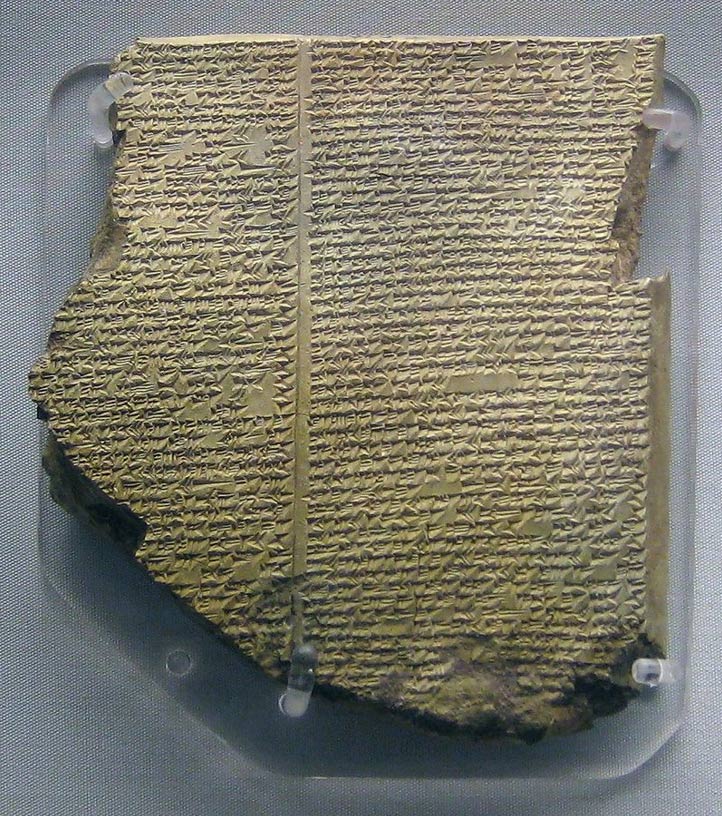
The Epic of Gilgamesh flood tablet, excavated at Nabu, Iraq, dated to 1150 BC. (British Museum/Public Domain)
In fact there are several other early writings which tell a consistently similar tale:
|
|
Eridu Genesis |
Sumerian King List |
Shuruppak |
Epic of Atrahasis |
Epic of Gilgamesh |
Bible - Book of Genesis |
Metamor-phosis by Ovid |
|
Date |
c.2300 BC |
2119-2112 BC |
c.2100 BC |
c.1640 BC |
c.1150 BC |
1000-500 BC |
c.700 BC |
|
Culture |
Sumerian |
Sumerian |
Akkadian |
Babylonian |
Babylonian |
Jewish |
Greek |
|
Hero |
Ziusudra |
Cush, Noah’s grandson |
Ziusudra |
Atrahasis |
Utnapishtim |
Noah |
Deucalion |
|
Destroyer god |
Enlil |
|
|
Enlil |
Enlil |
YHWH |
Zeus |
|
Warning god |
Enki |
|
|
Enki |
Enki |
YHWH |
Prometheus |
|
Reason |
Noise? |
|
|
Noise |
? |
Sin, giants |
Sin, giants |
|
Cause |
Storm/flood |
Flood |
Flood |
Rain |
Storm/flood |
Rain, fountains |
Rain, waves |
|
Period |
7 days |
|
|
7 days |
7 days |
40 days |
9 days |
|
Birds |
? |
|
|
? |
Raven, dove, swallow |
Doves, raven |
None |
|
Destination |
? |
|
|
? |
Nimus |
Ararat |
Parnassus |
|
Hero’s fate |
Eternal life |
|
|
Eternal life |
Eternal life |
3 sons |
3 grandsons |
These early Sumerian and Akkadian stories are clearly the origin of the version the flood legend in the Book of Genesis. Genesis 6:9 says: ‘Then the Lord saw that the wickedness of man was great in the earth, and that every intent of the thoughts of his heart was only evil continually. And the Lord was sorry that He had made man on the earth, and was grieved in His heart. So the Lord said, 'I will blot out man whom I have created from the face of the land, from man to animals to creeping things and to birds of the sky; for I am grieved that I have made them.'’
God then instructs Noah to build an ark, which he specifies to be three hundred cubits (about 450 feet/122 meters) long, fifty cubits (75 feet/23 meters) wide, and thirty cubits (45 feet/14 meters) high, and tells him to put in it one pair of unclean animals and seven pairs of clean animals. Once the vessel is completed ‘all the fountains of the great deep burst open, and the floodgates of the sky were opened’ and it rains for 40 days. On the seventeenth day of the seventh month, the ark rests upon the mountains of Ararat, and after a further 40 days god tells Noah to open the ark and ‘go forth and multiply’. Mount Ararat is a 17,000 foot (5200 meters) mountain in the Armenian highlands of eastern Turkey.
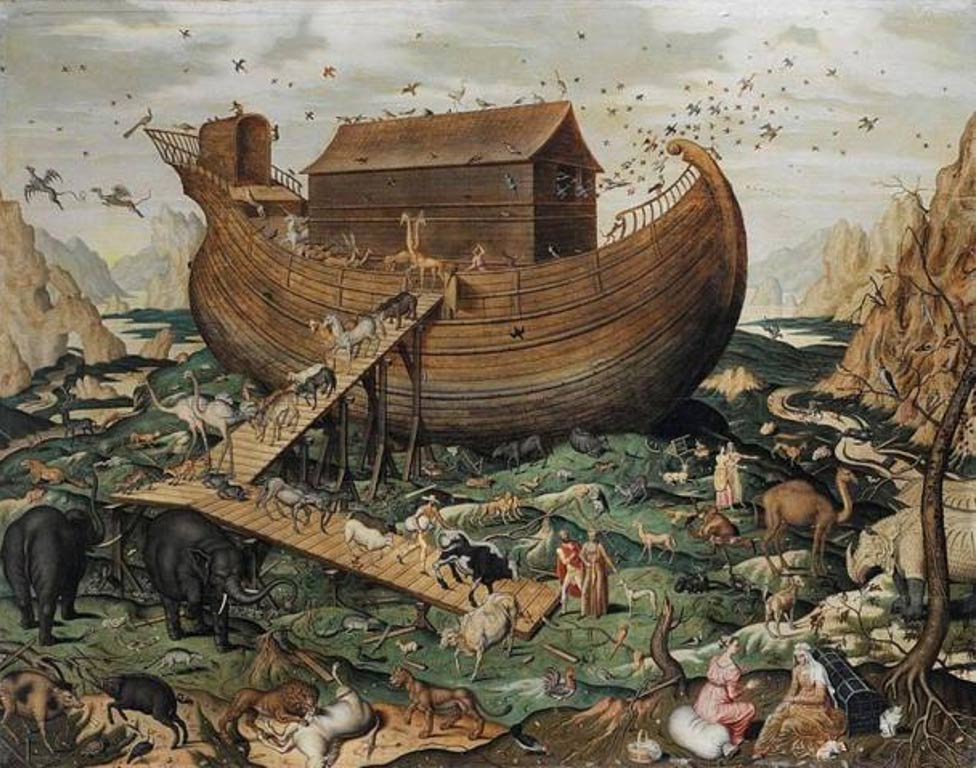
‘Noah's ark on Mount Ararat’ by Simon de Myle, 1570 AD. (Public Domain)
Another very early historical reference to the flood being in the Gulf region comes from a different source, the Sumerian King List, again one of the world’s earliest written records. This is a meticulous record of the rulers of Sumer preserved on clay tablets which states that there were ten rulers before ‘the great flood washed over the land’, and is then followed by the post-deluge list of monarchs. The list is hard to date – not least because many of the early kings are credited with living improbably long lengths of time (hundreds and even thousands of years) – but the best estimate from the list dates the flood at roughly 5,000 years ago.
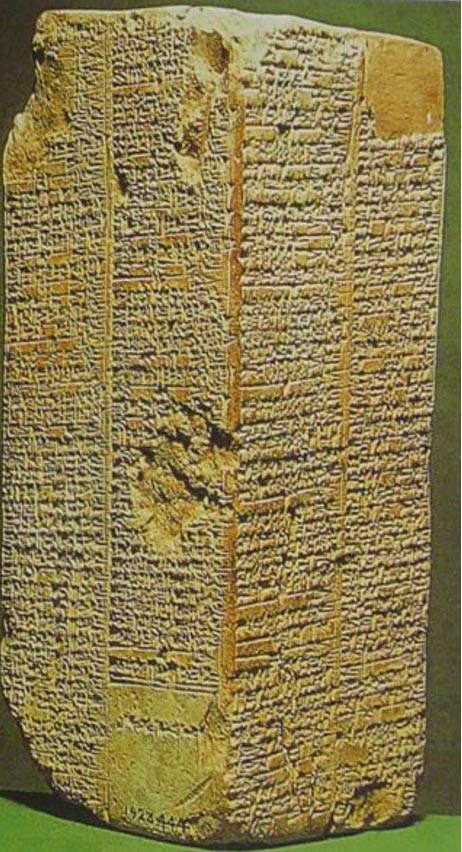
The best existing Sumerian King List. (Public Domain)
New Archaeological Evidence
If the Garden is really to be found beneath the present waters of the Gulf in the northern Gulf valley, will we ever have proof of its existence? In 2010 a major study was published which gives some tantalizing hints of what might be there. Dr. Jeffrey Rose is an authority on early man in the Arabian Peninsula and lists over 60 archaeological sites located around the shoreline of the Persian Gulf all dating from the same period, about 7,000 to 8,000 years ago – just when the inundation of the Gulf was nearing its maximum – and that all possessed similar cultural styles.
In his words there was at that time a “virtual explosion of settlement around the shoreline of the Gulf… coinciding with the final phase of marine incursion” all along the entire eastern coast of the Arabian Peninsula, mostly around Kuwait, Saudi Arabia and Bahrain, but with other sites in Qatar and the UAE. So many settlements all in the same area and from the same date obviously had a common origin, it would be too much of a coincidence for them not to.
Moreover, in sharp contrast to the scattering of hunter-gatherer camps that had hitherto been the only signs of human occupation in this area, these new settlers were clearly more advanced people than the hunter-gatherers who had sparsely and nomadically inhabited the Arabian Peninsula for up to a hundred thousand years previously; they understood how to grow corn, domesticate animals, make pottery, and build houses and tombs, and were soon to develop the metallurgical skills which formed the basis of the first cities and civilizations.
Where had they developed such skills? Since there were no other people with such an advanced culture in the archaeological record anywhere in the surrounding region, Rose concludes that the only place they could have come from was the area now covered by the Persian Gulf itself. He goes on to suggest that this ‘Gulf Oasis’ had probably been a significant population center for tens of thousands of years, with humans repeatedly retreating there during periodic droughts and other times of climatic hardship.
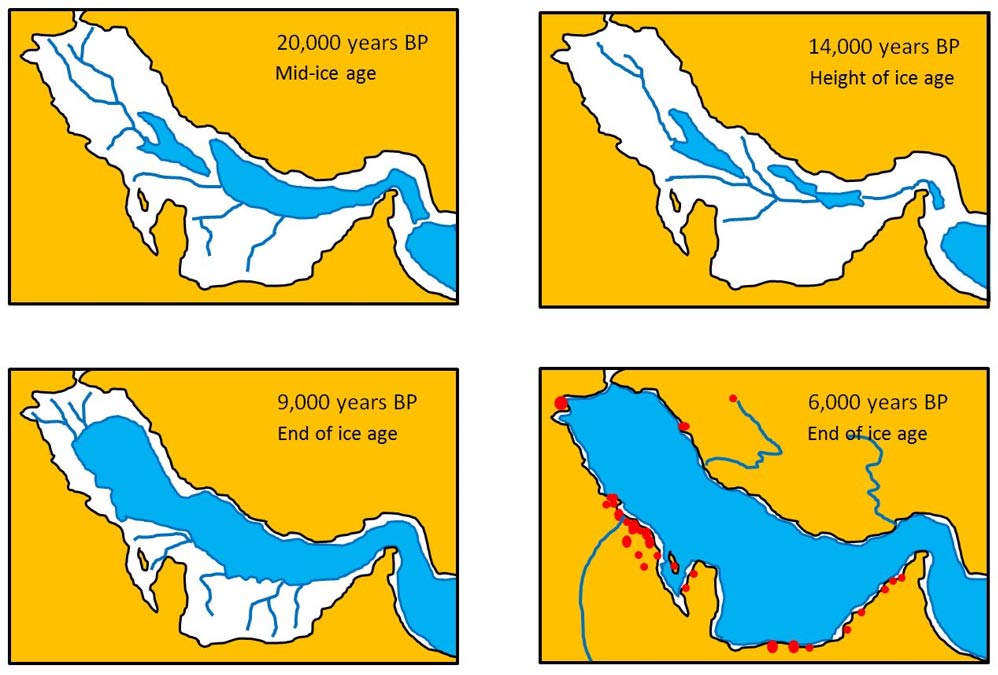
Palaeo-shoreline and drainage channels of Persian Gulf valley showing how the Gulf filled as the ice sheets melted. Red dots are Ubaid archaeological sites dating to about 7,000 to 8,000 yrs BP. After Rose (2010)
He believes that this ‘demographic refugium’ was the source of the people who made these new settlements all around the Gulf around 7,500 years ago, and was the original place from which people had been forced to flee until they stopped at the present coastline when the flooding ceased, all traces of their previous development and cultural history lost beneath the waters of the Gulf.
DNA analysis has also been used to try and determine how long people have lived in the region, and has shown that many of the current inhabitants of Arabia can trace their lineages back to 25-50,000 years ago. In fact some individuals tested display highly diversified haplogroup branches, suggesting that their ancestors have lived in the area considerably longer.
It would be simplistic to think that the Gulf was the only regional population center for humans during the ice age, and in fact there is evidence for other refugia south of the Empty Quarter, in the area between Dhofar in southern Oman and the Yemeni highlands, and another at the southern end of the Red Sea. However, an important difference is that those people are believed to have remained hunter-gatherers and never reached the level of civilization of the peoples living in the Gulf Oasis valley.
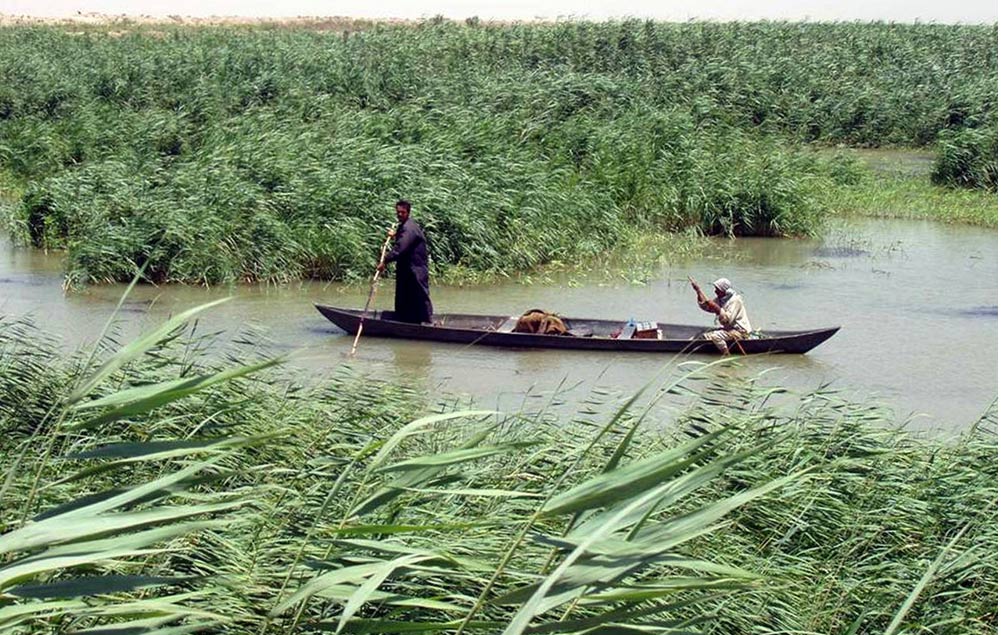
Marsh Arabs poling a mashoof (traditional boat) in the marshes of southern Iraq in the Tigris–Euphrates river system. (Public Domain)
This constitutes the strongest archaeological evidence we currently have that humans lived and flourished beneath the present Persian Gulf around 8,000 years ago, and in a location that matches the written description of where the Garden of Eden was.
Will we ever be able to excavate those sub-marine sites? Recent advances in marine archaeology have been successful in recovering artifacts from similar sites which were submerged at the end of the last ice age, such as Doggerland beneath the North Sea, and multiple teams are now looking beneath the Persian Gulf to try and find traces of human settlement there too. There is every chance that within the next 10 to 20 years physical evidence of human habitation beneath the Persian Gulf such as houses and other artifacts will be found.
As for new historical evidence, well you never know. There are apparently over 100,000 Sumerian tablets in storage at the British Museum, untranslated and uncatalogued. Perhaps amongst them are older stories, yet to be discovered…
David Millar, author of Beyond Dubai: Seeking Lost Cities in the Emirates
Featured image: How Europeans saw the Garden of Eden in the Middle Ages. Painting by Lucas Cranach the Elder (1472-1553) (Public Domain)
References
The Archaeology of the Bible, James K. Hoffmeier, Lion Hudson, 2008
Beyond Dubai: Seeking Lost Cities in the Emirates, David Millar, Melting Tundra Publishing, 2014
New Light on Human Prehistory in the Arabo-Persian Gulf Oasis, J.I. Rose, Current Anthropology, vol 51, no 6, 2010
Has the Garden of Eden been found at last?, Dora Hamblin, Smithsonian Magazine, 1987
What Really Happened in the Garden of Eden?, Ziony Zevit, Yale University Press, 2013